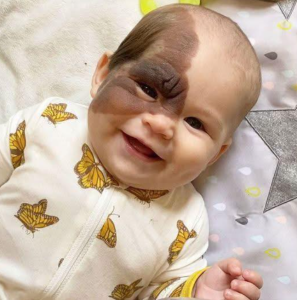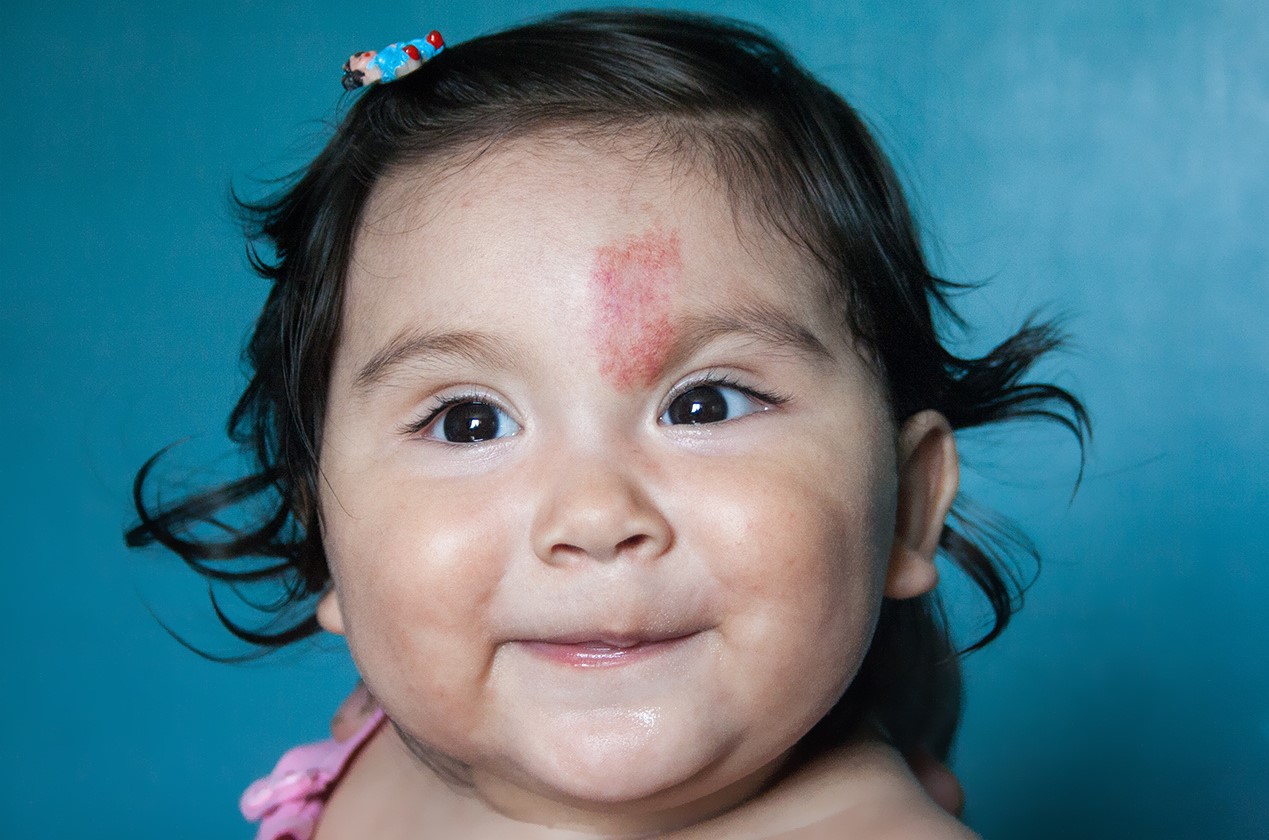
When their daughter was born, the first thing her parents noticed wasn’t the soft curve of her cheeks or her curious eyes — it was the mark that stretched across her left cheek. It was a noticeable birthmark, large and dark, and though it didn’t affect her health, it was something the family knew would shape her life in ways far beyond the surface.
From the moment they brought her home from the hospital, the young couple made a silent promise: they would do everything in their power to protect her, not just from physical harm, but also from the cruel judgment the world often has for those who look “different.”
At first, the birthmark was simply a part of who their little girl was. To them, it didn’t make her less beautiful — if anything, it made her unique. But as she grew older, they began to notice the way others reacted. Strangers in grocery stores stared too long. Other children whispered or asked blunt questions without meaning harm. And some adults, less kind, made comments that pierced like knives.
When their daughter started preschool, things became more painful. She was a bright, confident child, always eager to play and share stories. But her parents began to notice subtle changes in her. She came home quieter. She avoided mirrors. When they asked about her day, she would shrug and change the subject. One afternoon, after a particularly difficult day at school, she burst into tears and asked her mother a question that broke her heart:
“Why do I have this on my face? Why am I not like the other kids?”
Her parents held her tight, fighting their own tears. They told her she was perfect, that she was strong, that she was loved. But deep inside, they knew this wasn’t just about looks — it was about her future. They feared what the teenage years might bring: the bullying, the insecurity, the endless comparisons. And so, after many sleepless nights and heartfelt conversations, they made a difficult decision.
They would remove the birthmark.
The journey was neither easy nor simple. They met with several specialists in pediatric dermatology and plastic surgery. Every doctor they spoke to carefully explained the options, the risks, and the emotional weight such a decision carried. Removing a birthmark of that size would require multiple laser treatments or possibly surgical procedures, depending on how her skin responded.
But the parents were determined. It wasn’t about changing who their daughter was — it was about giving her a chance to walk into the world without having to explain herself at every turn.
The day of the first treatment was one they would never forget. Their little girl, nervous but brave, clutched her father’s hand as they walked into the hospital. She was too young to fully understand everything, but she knew something important was happening. Her parents kept their voices calm, their smiles steady, even as their hearts raced with fear and hope.
The procedure itself went smoothly. When she woke up afterward, groggy but safe, her mother kissed her forehead and whispered, “You’re so brave. We’re so proud of you.”
Over the following months, she underwent several treatments. Each session came with its own challenges — the discomfort, the healing, the emotional toll. But as the birthmark gradually lightened, something else began to change too: her confidence.
She started smiling more in photos. She no longer turned away when someone looked at her face. At school, she began to speak up again, joining games and making new friends.
The parents knew the mark would never fully disappear — and in truth, they didn’t want it to. It was a part of her story, a reminder of where she came from and how loved she was. But what mattered most was how she felt about herself. And for the first time in a long while, she felt free.
Their decision was not without criticism. Some people online accused them of giving in to society’s shallow beauty standards. Others said they should have let their daughter “embrace her uniqueness.” But what outsiders didn’t see was the quiet pain behind her smile, the way she had begun to shrink from the world.
For these parents, love wasn’t about making their daughter perfect. It was about giving her a choice — something they didn’t want the world to take away from her.
As she grew older, she would understand the full story. She would learn how her parents agonized over every step, how they weighed every risk, how they held her hand through it all. One day, she would look in the mirror and see not just her reflection, but the love and strength that carried her through those early years.
Years later, she would tell her parents, “Thank you for listening to me. Thank you for giving me a chance to be me.”
Their decision wasn’t about erasing her difference. It was about helping her live without fear of judgment. It was about making sure that the world saw her for her laughter, her intelligence, her kindness — not just the mark on her cheek.
This story is a quiet reminder that every family faces choices that outsiders may never fully understand. Love sometimes means accepting. Other times, it means taking action. In this case, it meant walking a long, difficult road together — and coming out stronger on the other side.
For this little girl and her parents, the birthmark was never a flaw. It was a beginning. And their love became the steady light that guided her toward a future where she could define herself on her own terms.
By the time she reached her teenage years, the mirror no longer frightened her. She saw not scars or marks, but a girl who had overcome so much. She carried that strength with her everywhere she went.
And her parents — who had once stood trembling outside the hospital room doors — now watched her walk boldly into the world, smiling, unafraid, and radiant.
In the end, it wasn’t the removal of the birthmark that changed her life. It was the unwavering love behind that decision. A love that gave her courage. A love that gave her wings. A love that never let go.


